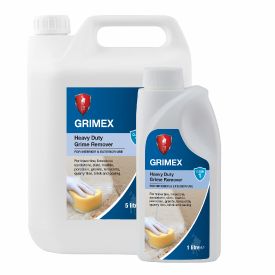
Limestone is a hardwearing surface that’s really easy to maintain, but correct cleaning products should always be used. All limestone tiles, regardless of colour and finish, are sensitive to acid, so they should be cleaned with a pH-neutral detergent. General household tile and surface cleaners tend to be acidic and will etch the stone along with the grout joint and damage any protective sealer applied. They will also dull a polished finish. Even quality ‘eco’ surface sprays and anti-bacterial sanitisers often contain acidic ingredients, so always read the small print to check if a product is suitable.
Home-made cleaning hacks & steam cleaning
Homemade solutions and steam cleaning are two other cleaning methods to avoid. The most common homemade hacks - vinegar, lemon and baking soda – are all very acidic and will damage limestone. Bleach should also be avoided; whilst it is alkaline, rather than acidic, it is still too harsh for natural stone. Steam cleaning isn’t recommended either, as it can damage a stone sealer and compromise protection. Intense heat can also cause ‘spalling’ or flaking of the limestone.
What to use for routine and deep cleaning
A regular ‘routine’ clean will maintain a hygienic environment and a tile’s aesthetic. Once grease and dirt builds up on a surface, tiles will be more difficult to clean, and they may become slippery. A periodic deep clean in high traffic areas may also be necessary. Often, the same detergent can be used for routine and deep cleaning, with the dilution ratio and method adjusted in each case. This is the case with LTP Grimex – the detergent that we recommend for limestone floor tiles.
Methods for routine and deep cleaning
Routine cleaning with LTP Grimex:
1. Sweep or vacuum the floor, to remove dust and loose dirt.
2. Dilute one part LTP Grimex in 10 parts warm water.
3. Apply with a cloth or mop. Wipe off thoroughly with a clean damp cloth.
Deep cleaning with LTP Grimex:
1. Sweep or vacuum the floor to remove dust and loose dirt.
2. Dilute one part LTP Grimex in 3 parts warm water.
3. Apply liberally, spreading over the surface of the tiles. If necessary, agitate with a scrubbing brush.
4. Leave to react for 5-10 minutes, keeping the surface wet with additional solution. Agitate surface again, mop up and rinse thoroughly with clean water.

How to maintain a seamless surface, from home to garden
If the same limestone tile is installed from inside to outside - for example, through bi-fold doors - it’s important to maintain both areas to avoid an unsightly contrast. Whilst LTP Grimex can be used on outdoor slabs, a specialist external treatment will help tackle issues specific to paths and patios, like black spot, lichen and moss which cause discoloration and create a slip hazard. We recommend LTP Blackspot & Algae Remover.
How to remove stubborn stains
If staining is still present on a floor that has been deep cleaned, we recommend use of a specialist treatment. Various solutions are available to safely remove common stains, like oil and grease, rust, wax, grout and salt residue. LTP’s full range of intensive cleaners, for all tile types, are shown here. Always check that the product is suitable for limestone. If the treatment is designed to strip the surface, you will need to re-apply a sealer to reinstate stain protection.
For more advice on the best maintenance regime for your limestone floor, please call the LTP technical team on 01823 666213 or email [email protected]



